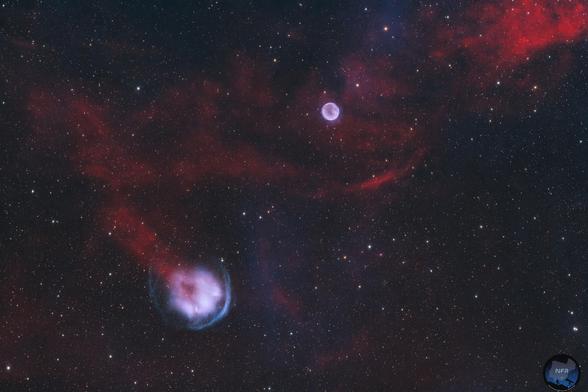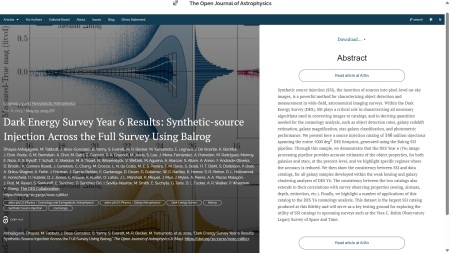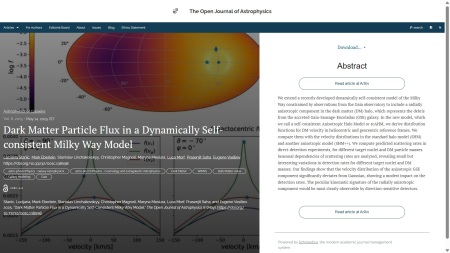Most stars in the universe come in pairs. In a binary system, two stars orbit a common center of mass. Some, like V664 Cas, evolve into spectacular sights. This red giant and white dwarf orbit every 0.58 days, creating the planetary nebula HFG1 and a glowing arc-shaped shockwave.
📷 Julien Cadena & Mickael Coulon
🔗 stellarsnap.space
#BinaryStars #PlanetaryNebula #HFG1 #Astronomy #StellarSnap #Space
Weekly Update from the Open Journal of Astrophysics – 31/05/2025
Once again it’s time for the weekly Saturday morning update of papers published at the Open Journal of Astrophysics. Since the last update we have published five new papers, which brings the number in Volume 8 (2025) up to 67; the total so far published by OJAp has passed the 300 mark and is now up to 302. If we keep up at the same rate for the rest of the year as we did for the first five months now completed, we will publish around 160 papers altogether in 2025.
In chronological order of publication, the five papers published this week, with their overlays, are as follows. You can click on the images of the overlays to make them larger should you wish to do so.
The first paper to report is “Which is the most eccentric binary known? Insights from the 2023/4 pericenter passages of Zeta Boötis and Eta Ophiuchi” by Idel Waisberg, Ygal Klein and Boaz Katz (Weizmann Institute of Science, Israel). This is a report of interferometric observations of two very eccentric binary star systems, published on Tuesday 27th May 2025 in the folder Solar and Stellar Astrophysics. The overlay is here:
You can read the final accepted version on arXiv here.
The second paper to report is “On the full non-Gaussian Surprise statistic and the cosmological concordance between DESI, SDSS and Pantheon+” by Pedro Riba Mello & Miguel Quartin (Universidade Federal do Rio de Janeiro, Brazil), and Bjoern Malte Schaefer & Benedikt Schosser (Heidelberg, Germany). This paper is in the folder Cosmology and NonGalactic Astrophysics and was published on Tuesday 27th May 2025. The paper presents an application of the “Surprise Statistic”, based on the Kullback-Leibler divergence, as a measure of the difference between results inferred from different data sets.
The overlay is here:
You can find the officially-accepted version of the paper on arXiv here.
The third paper we published last week, and our 300th overall, is “Cosmic Ray Feedback in Massive Halos: Implications for the Distribution of Baryons” by Eliot Quataert (Princeton, USA) and Philip F. Hopkins (Caltech, USA). This was published on Thursday 29th May in the folder Cosmology and NonGalactic Astrophysics. The paper discusses the effects of cosmic rays produced by massive black holes on the structure of the baryonic component of galaxies and how these might affect cosmological parameter estimation. The overlay is here:
You can read the officially accepted version of this paper on arXiv here.
The next one to report is “Mixing neutron star material into the jets in the common envelope jets supernova r-process scenario” by Noam Soker (Technion, Israel). This was published on Thursday 27th May in the folder High-Energy Astrophysical Phenomena; it presents a discussion of the chemical enrichment of an evolved star consequent upon its ingestion of a neutron star.
The overlay is here:
You can find the officially accepted version on arXiv here.
Last, but by no means least, for this week we have “Dark Energy Survey Year 6 Results: Synthetic-source Injection Across the Full Survey Using Balrog” by Dhayaa Anbajagane (Kavli Institute, Chicago) et al. (81 authors) on behalf of the Dark Energy Survey Collaboration. It was also published on Thursday 27th May 2025, but in the folder Cosmology and NonGalactic Astrophysics. It is about testing the Dark Energy Survey analysis pipeline using synthetic sources.
The overlay is here:
You can find the officially accepted version on arXiv here.
That’s all the papers for this week. I’ll post another update next weekend.
#arXiv240808385v2 #arXiv250105683v3 #arXiv250201753v2 #arXiv250202411v2 #arXiv250417858v2 #binaryStars #CosmologyAndNonGalacticAstrophysics #DarkEnergySurvey #DiamondOpenAccess #DiamondOpenAccessPublishing #HighEnergyAstrophysicalPhenomena #neutronStar #OpenJournalOfAstrophysics #rProcess #SolarAndStellarAstrophysics #TheOpenJournalOfAstrophysics
Weekly Update from the Open Journal of Astrophysics – 24/05/205
It’s time once again for the regular Saturday update of papers published during the past week at the Open Journal of Astrophysics. Since the last update we have published three new papers, which brings the number in Volume 8 (2025) up to 62 and the total so far published by OJAp up to 297.
In chronological order of publication, the three papers published this week, with their overlays, are as follows. You can click on the images of the overlays to make them larger should you wish to do so.
The first paper to report is: “Jet-shaped filamentary ejecta in common envelope evolution” by Ron Schreier, Shlomi Hillel and Noam Soker (Technion, Haifa, Israel). This paper, which was published on Monday May 19th 2025 in the folder High-Energy Astrophysical Processes, presents three-dimensional hydrodynamical simulations of common envelope evolution of a neutron star inside the envelope of a rotating red supergiant with Rayleigh-Taylor instabilities forming filamentary ejecta.
The overlay is here:
You can find the officially accepted version on arXiv here.
Second one up is “Weighing The Options: The Unseen Companion in LAMOST J2354 is Likely a Massive White Dwarf” by M. A. Tucker, A. J. Wheeler & D. M. Rowan (Ohio State University, USA) and M. E. Huber (U. Hawaii, USA). This paper was published on Tuesday 20th May 2025 in the folder for Solar and Stellar Astrophysics. It discusses a spectroscopic study of the binary system LAMOST J235456.73+335625 (J2354) with a discussion of the implications for the nature of the dark component.
The overlay is here:
You can find the officially-accepted version of the paper on arXiv here.
The third and last paper of the week, published on Thursday May 22nd 2025, also in the folder Solar and Stellar Astrophysics, is “How to use Gaia parallaxes for stars with poor astrometric fits” by Kareem El-Badry (Caltech, USA). This paper presents a method for extracting reasonable estimates of stellar parallaxes from Gaia data when the overall astrometric solution is unreliable due to errors and noise
Here is the overlay:
You can find the officially accepted version of this paper on arXiv here.
That’s all the papers for this week. Looking at the publishing workflow, I expect we will pass the 300 mark next week. We’ll see when I post the next update next Saturday.
#arXiv240719004v2 #arXiv250109663v3 #arXiv250411528v2 #astrometry #binaryStars #commonEnvelopeEvolution #DiamondOpenAccess #GAIA #HighEnergyAstrophysicalPhenomena #hydrodynamics #LAMOSTJ2354 #LAMOSTJ23545673335625 #OpenJournalOfAstrophysics #parallax #SolarAndStellarAstrophysics #stars #TheOpenJournalOfAstrophysics #whiteDwarfs
Weekly Update from the Open Journal of Astrophysics – 17/05/2025
It’s a lovely Saturday morning in May, and it’s time for the weekly update of papers published at the Open Journal of Astrophysics. Since the last update we have published four new papers, which brings the number in Volume 8 (2025) up to 59 and the total so far published by OJAp up to 294.
In chronological order of publication, the four papers published this week, with their overlays, are as follows. You can click on the images of the overlays to make them larger should you wish to do so.
The first paper to report is: “Multi-Phase Thermal Structure & The Origin of the Broad-Line Region, Torus, and Corona in Magnetically-Dominated Accretion Disks” by Philip F. Hopkins (Caltech, USA). This was published on Monday May 12th in the folder Astrophysics of Galaxies. It presents simple accretion disk model that predicts the properties of many features including the dusty torus, broad-line region, continuum emission and coronal gas.
The overlay is here:
You can find the officially accepted version on arXiv here.
Second one up is “Sparsity covariance: a source of uncertainty when estimating correlation functions with a discrete sample of observations in the sky” by Pierre Fleury (U. Montpellier, France). This one was published on Tuesday 13th May 2025 in the folder Cosmology and NonGalactic Astrophysics. This paper presents a discussion of the uncertainty in cosmological observables caused by discrete sampling and a method to compute the covariances resulting from this.
The overlay is here:
You can find the officially-accepted version of the paper on arXiv here.
The third paper of the week, published on Wednesday May 14th 2025, is “Dark Matter Particle Flux in a Dynamically Self-consistent Milky Way Model” by Lucijana Stanic, Mark Eberlein, Stanislav Linchakovskyy, Christopher Magnoli, Maryna Mesiura, Luca Morf, Prasenjit Saha (University of Zurich, Switzerland) and Eugene Vasiliev (University of Surrey, UK). This one presents a study of the behaviour of dark matter in an anisotropic model for the Milky Way halo with implications for particle detection rates. It is in the folder Astrophysics of Galaxies.
Here is the overlay:
You can find the officially accepted version of this paper on arXiv here.
The last paper published this week is “Too fast to be single: Tidal evolution and photometric identification of stellar and planetary companions” by Ilay Kamai and Hagai B. Perets (Technion, Haifa, Israel). This one was published on Friday 16th May 2025 in the folder Solar and Stellar Astrophysics. It presents an analysis of the rotation of stars observed in the Kepler field to identify non-single systems with high spin rates resulting from tidal effects.
Here is the overlay:
The official published version can be found on the arXiv here.
That’s all the papers for this week. I’ll post another update next week.
#accretionDisk #arXiv240700160v2 #arXiv250208805v2 #arXiv250218327v2 #arXiv250303839v2 #AstrophysicsOfGalaxies #binaryStars #CosmologyAndNonGalacticAstrophysics #DiamondOpenAccessPublishing #magnetizedDisks #OpenJournalOfAstrophysics #SolarAndStellarAstrophysics #TheOpenJournalOfAstrophysics
Binary Stars: What If Two Suns Danced?
Webb Watches Carbon-Rich Dust Shells Form, Expand in Star System - NASA Science
Astronomers have long tried to track down how elements like carbon, which is essential for life, become widely distributed across the universe. Now, NASA’s James Webb Space Telescope has examined one ongoing source of carbon-rich dust in our own Milky Way galaxy in greater detail: Wolf-Rayet 140, a system of two massive stars that follow […]
https://www.bbc.com/future/article/20241223-the-search-for-the-suns-missing-twin #astronomy #cosmology #BinaryStars





